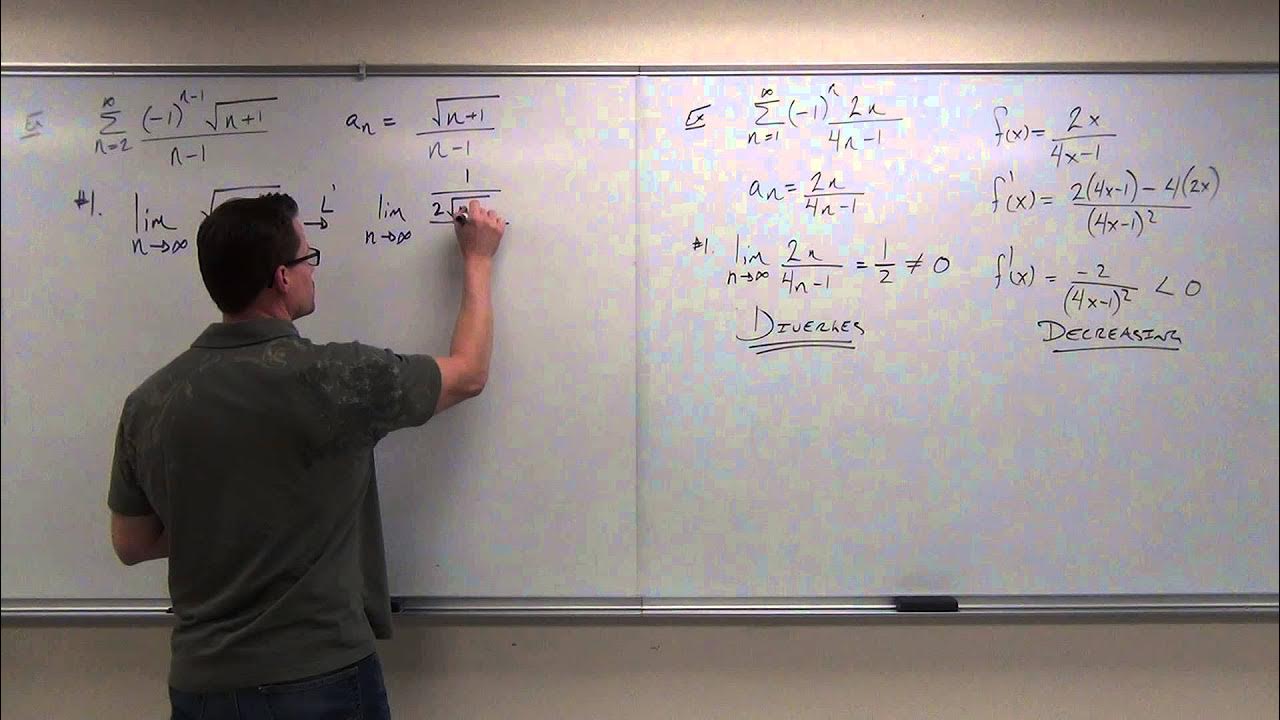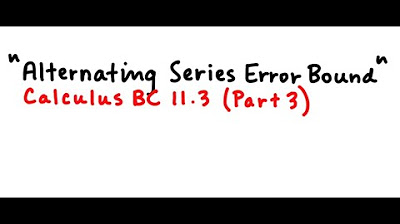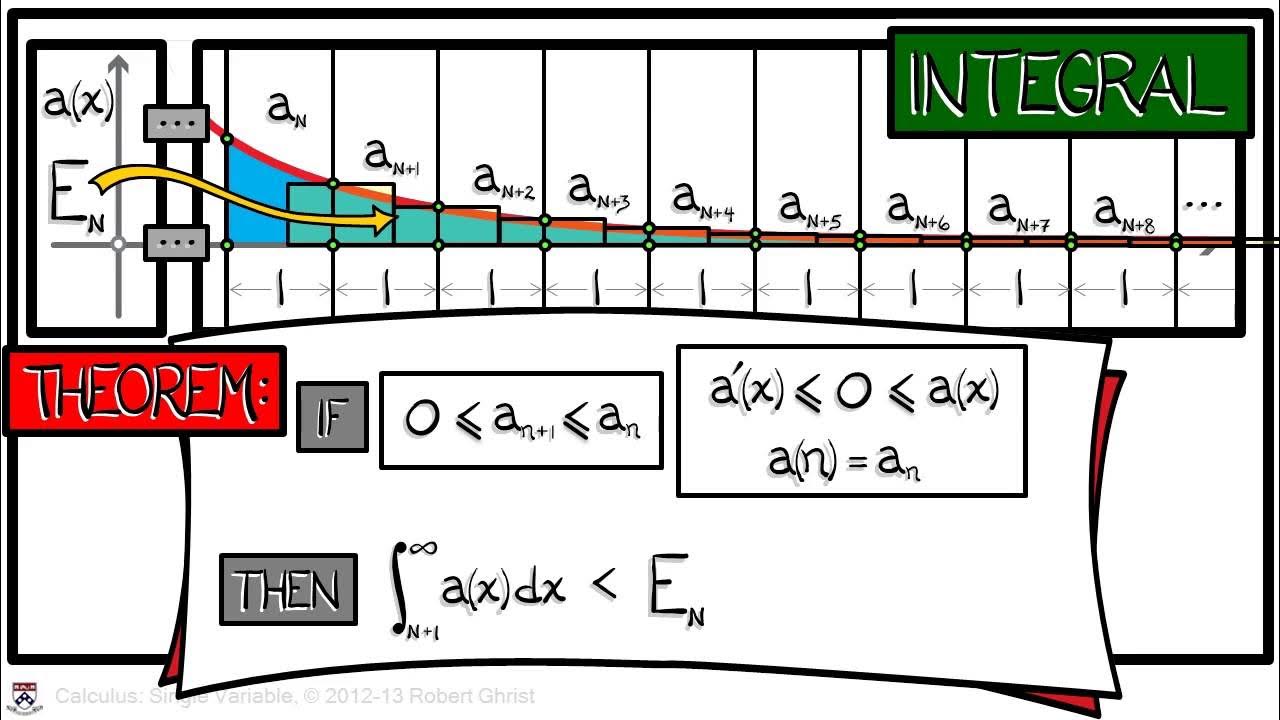AP Calculus BC Lesson 10.10
TLDRThis video lesson delves into the concept of alternating series error bounds, explaining how they can be used to approximate the sum of a convergent series. The alternating series test is introduced, and its application is demonstrated through examples, including the alternating harmonic series. The video also covers how to calculate the remainder or error in approximations using partial sums and illustrates the process with step-by-step calculations and graphical representations. The aim is to provide a clear understanding of how the error bound can estimate the accuracy of the approximation, with a focus on using the first few terms of a series to achieve a desired level of precision.
Takeaways
- 📝 The alternating series error bound is a method to estimate the difference between the actual sum of a series and the sum of its first n terms.
- 🔢 If a series converges by the alternating series test, the error bound is the absolute value of the next term (a sub n plus 1).
- 📊 The alternating harmonic series is used as an example to demonstrate the calculation of the error bound and approximation of the series sum.
- 🌟 The concept of remainder (R sub n) is introduced as the difference between the actual series sum and the partial sum approximation.
- 📈 The error bound helps in creating a window or interval within which the actual sum of the series is likely to fall.
- 📚 The alternating series test is a specific topic with its own video, providing the foundational understanding for this lesson.
- 🔍 The approximation of a series sum becomes more accurate as more terms are included in the partial sum.
- 📐 The graphical representation of the series terms and partial sums helps visualize the convergence and accuracy of approximations.
- 🧮 The use of calculators is recommended for simplifying and computing the sums and error bounds of series terms.
- 📝 The script provides step-by-step instructions on how to calculate the alternating series error bound for various series.
- 📊 The concept of the error bound is crucial for understanding how close an approximation using a finite number of terms is to the actual sum of an infinite series.
Q & A
What is the main topic of discussion in this video?
-The main topic of discussion in this video is the alternating series error bound.
What does the alternating series test imply about a series that converges?
-If a series converges by the alternating series test, the absolute value of the difference between the actual value of the series and the sum of the first n terms is less than or equal to the absolute value of the next term (a_sub_n_plus_1).
What is the meaning of R_sub_n in the context of the alternating series test?
-R_sub_n represents the remainder, which is the difference between the actual value of the series and the approximation using the first n terms.
How can the sum of an alternating series be approximated?
-The sum of an alternating series can be approximated by adding up the first n terms, also known as the partial sums.
What is the alternating harmonic series mentioned in the video?
-The alternating harmonic series is the series from n equals 1 to Infinity of (-1)^(n+1) / n, where n starts at 1.
How does the video approximate the sum of the alternating harmonic series using the first six terms?
-The video approximates the sum of the alternating harmonic series by calculating the sixth partial sum, S_sub_6, which equals the sum of the terms a_sub_1 through a_sub_6, resulting in a decimal approximation of 0.616 repeating.
What does the term 'a_sub_n_plus_1' represent in the context of the alternating series error bound?
-In the context of the alternating series error bound, 'a_sub_n_plus_1' represents the next term in the series, which is also referred to as the error bound.
How can the alternating series error bound be used to estimate the accuracy of an approximation?
-The alternating series error bound can be used to estimate the accuracy of an approximation by stating that the actual sum of the series lies somewhere between the partial sum approximation plus the error bound (the absolute value of the next term) and the partial sum approximation minus the error bound.
What is the significance of the graphical representation of the series and its partial sums in the video?
-The graphical representation helps to visualize how the value of the partial sums approaches the actual value of the series as n increases, and it also illustrates the concept of the error being less than or equal to the absolute value of the next term in the series.
How does the video approximate the sum of a convergent series using the first four terms of the series from n equals 1 to Infinity of (-1)^n / (7 * n^3)?
-The video approximates the sum by calculating the fourth partial sum, S_sub_4, which equals the sum of the terms from n equals 1 to 4, resulting in an approximation of -0.101985.
What is the range within which the actual sum of the series from n equals 1 to Infinity of (-1)^n / (7 * n^3) lies when approximated by the first four terms?
-When approximated by the first four terms, the actual sum of the series lies somewhere between -0.115 and -0.089.
Outlines
📚 Introduction to Alternating Series Error Bound
This paragraph introduces the concept of the alternating series error bound, explaining how it quantifies the difference between the actual value of a convergent series and the sum of its first n terms. It clarifies that if a series converges according to the alternating series test, the error bound (R sub n) is the remainder term a sub n plus 1, which must be less than or equal to the absolute value of the difference between the series' actual value (s) and its nth partial sum (S Sub n). The paragraph uses the alternating harmonic series as an example to demonstrate how to approximate the series sum and calculate the error bound.
📈 Graphical Context and Approximation
The second paragraph delves into the graphical representation of the series terms and partial sums, illustrating how the partial sum values approach the actual series value as n increases. It emphasizes the use of the alternating series error bound to estimate the approximation error, using the absolute value of the next term (a sub 7) as a measure. The paragraph also discusses approximating the sum of a convergent series using the first four terms and calculates the actual value interval for the series using the error bound.
🔢 Calculating Error Bounds and Approximations
This paragraph focuses on calculating the error bounds and approximations for different convergent series. It explains how to use the alternating series error bound to determine the number of terms required for a given error tolerance, exemplified by the series from n equals 1 to Infinity of negative 1 to the power of n over e to the power of n. The paragraph also addresses the process of approximating the sum of a convergent series using the first three terms and determining the interval for the actual value of the series based on the error bound.
📊 Determining Term Count for Specific Error Tolerance
The fourth paragraph discusses the process of determining the minimum number of terms needed to approximate the sum of a convergent series within a specific error tolerance, less than 0.01. It explains the mathematical process of setting up the inequality based on the alternating series error bound and solving for the required term count (n). The paragraph concludes with the calculation of the term count, indicating that four terms are needed for the approximation with an error less than 0.01.
📐 Analyzing Series Convergence and Error Bounds
This paragraph analyzes the convergence of a series and its associated error bounds. It establishes that the series is alternating and uses the alternating series error bound to determine the accuracy of approximations based on the number of terms used. The paragraph addresses the continuity and positivity of the function a sub n and discusses the implications of these properties on the error bounds for partial sums S Sub n. It concludes with the identification of the correct statement that must be true regarding the series and its partial sums.
🔍 Least Value of K for Specific Error Tolerance
The final paragraph focuses on finding the least value of K for which the alternating series error bound ensures that the absolute value of the difference between the actual series sum (s) and the partial sum S Sub K is less than or equal to a specific error tolerance (eleven one thousandths). It outlines the process of setting up and solving the inequality based on the error bound, leading to the determination of the minimum number of terms required for the approximation. The paragraph concludes with the identification of the correct choice for the least value of K that satisfies the inequality.
Mindmap
Keywords
💡Alternating Series
💡Convergence
💡Error Bound
💡Partial Sum
💡Remainder
💡Approximation
💡Harmonic Series
💡Series Sum
💡Absolute Value
💡Term
Highlights
The lesson discusses the alternating series error bound, a concept in understanding the convergence of series.
The alternating series test provides a way to determine if a series converges and to estimate the error in approximating the sum of the series.
The remainder, or error (R_n), in an approximation is defined as the difference between the actual value of the series and the sum of the first n terms.
The error bound is the absolute value of the next term in the series (a_(n+1)), which gives an upper limit on the error.
An example is given using the alternating harmonic series to illustrate how to approximate the sum of a series using partial sums.
The alternating harmonic series is defined
Transcripts
Browse More Related Video

Calculus 2 Lecture 9.5: Showing Convergence With the Alternating Series Test, Finding Error of Sums

Alternating Series Day 2

Alternating Series Error Bound

Alternating series remainder | Series | AP Calculus BC | Khan Academy

Calculus BC – 10.10 Alternating Series Error Bound

Calculus Chapter 5 Lecture 56 Approximation & Error
5.0 / 5 (0 votes)
Thanks for rating: